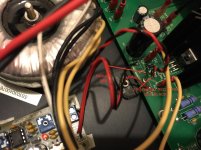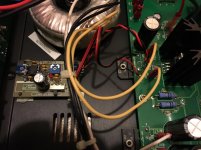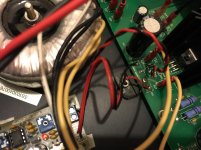60Hz To 50Hz KRC-3
Zdravím a jak jsi to vyřešil ??? Hello and how you solved it?Hi,
I have a problem.Could you help me?I have a KRELL 7.1 showcase processor,I bought from US,but I live in UK,so I can 't use,because the frequency 50Hz in UK,voltage 230V.
do you offer me any modify in Krell? upgrade kit,or build 60Hz clock signal generator?
Regards,sonyvaio2006
krell showcase processor
Mane is Juan. Spain
Could you tell me how you solved the change 110V 60 Hz to 220V 50 Hz. Could you send me a photo of change.
Krell showcase processor.
Thank you.
Anyone found the way to get Krell Showcase Processor working on 230/50HZ ? I have used a transformer to 110V but when power on, the unit said AC Line error. So it should be the frequency lock, right ?
Any help would be appreciated.
No, it was not mine, but I made it for a friend and it works !
Philippe
Mane is Juan. Spain
Could you tell me how you solved the change 110V 60 Hz to 220V 50 Hz. Could you send me a photo of change.
Krell showcase processor.
Thank you.
Thank you.
The Master kit A047 (square wave generator) where you can buy? a website?.
the kit is to recognize the 60HZ. but that changes must be made in the power supply to 240V?
It is supposed to come prepared to 110V
many thanks for your time.
It appears Krell are using a frequency detector to prevent users bypassing the profit margin of the local importer.
You need to change the voltage and change the frequency detector.
The local importer will do this for you and include his profit margin in the cost.
The EU should outlaw this restrictive practice !
You need to change the voltage and change the frequency detector.
The local importer will do this for you and include his profit margin in the cost.
The EU should outlaw this restrictive practice !
Hi, I've not been on this thread for a long time, but today I got a question about a Krell KRC-3, which actually contained the information I needed to help (disassembly listing).
The KRC-3 apparently has the same chip as the 300iL (m68hc711a9) and the person got the code from the eeprom using an xprog-m and ODA for disassembly. It's always much easier to help when things are made easy for me. The relevant code (I don't want to post it all since it's copyrighted) follows;
Comparing the code from the KRC-3 to the 300iL reveals a very similar subroutine at address 70 (compare to the code on page 13 of this thread);
load some initial values (0s), count and compare cycles, then compare count with a constant (091e), then return;
There are some similar routines at addresses 015e, 022e, 023c and 0264, but they appear a bit more complex so I'm rather thinking they might related to keypad input or similar.
Additionally, there's an infinite NO-OP loop at address 096, which might be called in case the frequency check fails.
you can sort of see that this infinite loop is called if the compare above fails.
Now, I have to warn you that I give no guarantees that if you change this code and run in your amp, it might damage it for all I know. I'd recommend trying it on a copy chip, ie. get a blank m68hc711a9 from an online vendor and copy all the code to it, and then do a modification. I no longer have any Krell amplifiers myself.
There's a difference in how this code handles the code above and below this point, so I don't think simply removing the infinite loop is sufficient, you would need to be able to return to the calling code. If you look at address 095 there's an RTS instruction, for return to caller;
if you simply disabled the NO-OP loop like I did on the 300iL, the code would continue on address 099;
and I have no idea what that code does.
I think the point of attack would be address 093. This is the one that does a jump to address 096 if the frequency check fails;
If we change this code, 2e 01, to 20 00, it would simply do nothing, and code execution would continue on address 095, which is the RTS we need;
I might leave it as an exercise for the reader to actually get the correct burn instruction for your particular setup..
The KRC-3 apparently has the same chip as the 300iL (m68hc711a9) and the person got the code from the eeprom using an xprog-m and ODA for disassembly. It's always much easier to help when things are made easy for me. The relevant code (I don't want to post it all since it's copyrighted) follows;
Comparing the code from the KRC-3 to the 300iL reveals a very similar subroutine at address 70 (compare to the code on page 13 of this thread);
load some initial values (0s), count and compare cycles, then compare count with a constant (091e), then return;
Code:
data:00000070 ce 00 00 ldx #0x00000000
data:00000073 18 ce 00 00 ldy #0x00000000
data:00000077 1e 00 08 fc brset 0x0,x, #0x08, 0x0x00000077
data:0000007b 1f 00 08 fc brclr 0x0,x, #0x08, 0x0x0000007b
data:0000007f 18 08 iny
data:00000081 01 nop
data:00000082 01 nop
data:00000083 1e 00 08 f8 brset 0x0,x, #0x08, 0x0x0000007f
data:00000087 18 08 iny
data:00000089 01 nop
data:0000008a 01 nop
data:0000008b 1f 00 08 f8 brclr 0x0,x, #0x08, 0x0x00000087
data:0000008f 18 8c 09 1e cpy #0x0000091e
data:00000093 2e 01 bgt 0x0x00000096
data:00000095 39 rts
data:00000096 0f sei
data:00000097 20 fd bra 0x0x00000096
data:00000099 d3 0e addd *0x0000000e
data:0000009b 15 23 7f bclr *0x00000023, #0x7f
data:0000009e dd 16 std *0x00000016
data:000000a0 13 23 80 fc brclr *0x00000023, #0x80, 0x0x000000a0
data:000000a4 39 rtsAdditionally, there's an infinite NO-OP loop at address 096, which might be called in case the frequency check fails.
Code:
data:00000096 0f sei
data:00000097 20 fd bra 0x0x00000096Now, I have to warn you that I give no guarantees that if you change this code and run in your amp, it might damage it for all I know. I'd recommend trying it on a copy chip, ie. get a blank m68hc711a9 from an online vendor and copy all the code to it, and then do a modification. I no longer have any Krell amplifiers myself.
There's a difference in how this code handles the code above and below this point, so I don't think simply removing the infinite loop is sufficient, you would need to be able to return to the calling code. If you look at address 095 there's an RTS instruction, for return to caller;
Code:
data:00000095 39 rts
Code:
data:00000099 d3 0e addd *0x0000000eand I have no idea what that code does.
I think the point of attack would be address 093. This is the one that does a jump to address 096 if the frequency check fails;
Code:
data:00000093 2e 01 bgt 0x0x00000096If we change this code, 2e 01, to 20 00, it would simply do nothing, and code execution would continue on address 095, which is the RTS we need;
Code:
data:00000095 39 rtsI might leave it as an exercise for the reader to actually get the correct burn instruction for your particular setup..
Hi guys,
Just want to share that I found this board which can burn 68MC711E9 chip on my Krell 400ix. it can use pcbug11/jbug11(windows version).
Adapt11 EVBU Module
Jbug: JBug11 version 5
Ordered and awaiting :)
Thanks for all who has shared in this post.
Just want to share that I found this board which can burn 68MC711E9 chip on my Krell 400ix. it can use pcbug11/jbug11(windows version).
Adapt11 EVBU Module
Jbug: JBug11 version 5
Ordered and awaiting :)
Thanks for all who has shared in this post.
I'm waiting for info because my Xprog-m didn't want to burn OTP even from 1 to 0
I've got the programming board. hopefully tomorrow I'll get USD-COM cable and started dump the data and do the burning.
One thing, I thought it needs 12v to burn it.
I'm waiting for info because my Xprog-m didn't want to burn OTP even from 1 to 0
I've done burning my chip, all works now after couple of months research.
I've done burning my chip, all works now after couple of months research.
Congratulation! The nice thing about fixing it yourself is that you made the amplifier your own. Now enjoy some music!
Congratulation! The nice thing about fixing it yourself is that you made the amplifier your own. Now enjoy some music!
Thanks for your help/inspiration in this post.
Been very busy these days. Once I have time, I'll post details for anyone who want to make this modification by themselves.
Hi All,
I've been doing home renovation work and very busy in past weeks. Finally I got some time to write something to thank everyone who offered help and hopefully it can also help others to flash this stupid chip
So first, you need to get a program board which I luckily found one with cheap price and awesome technical support. The board is Adapt11EVBU which is only $35+shipping.
Adapt11 EVBU Module
Technologicalarts also has a very helpful document/guide on how to burn the 711e9 chip:
Copying and Burning 68HC711E9 and E20 Chips
You'll need 12v power to flash/burn the chip. Without the power, the board can still read the chip.
You'll need plcc tool (very cheap through ebay from Chinese seller) to extract the chip. Though it's cheap, it's very handy.
You'll need to download jbug11. http://freespace.virgin.net/john.beatty/index.html
You'll also need serial cable (if you can find a computer with COM port) or USB-COM cable (which could have compatibility issue that people said USB-COM cable/converter with FTDI chip will be working for sure).
You may also get a empty 711e9 chip from ebay if you like (<$20)
Krell 400xi can change switches for different voltage input, when you open the lid, easy to see the 3 switches on the left. Here's some positions and voltage mapping:
2-1-2 115v
2-2-2 240v
Now let's get started.
Refer to the guide above
---------------
Anyone who is interested on how I made the S19 file, please keep reading.
You'll need to understand the s19 format http://home.earthlink.net/~tdickens/68hc11/docs/s19_file_format.html
If you want to decode the S19 file, you can download the app below and we actually only need decoder.exe within this big application
Evaluation Software|NXP

Locate decoder.exe, should be under Freescale\S12lisa_Tools\Build_Tools
Run it, in Decoder-options, in input tab, enable 'Set Processor' and put HC12 in it because it's required for decoding S19 file. You may find the info in the decoder user guide.
You'll need to save a new project with the above settings.
Then you can just drag and drop the S19 file into Decoder and it will generate a .lst file in same folder which has decoded info as below:
0000D3BD D2FE SBCB $FE
0000D3BF BDE7AC CPY $E7AC
0000D3C2 20FE BRA *+0 ;abs = $D3C2
0000D3C4 BDD744 CPY $D744
0000D3C7 BDD73D CPY $D73D
Actually you don't even need to decode the S19 file, you can just find '20FE' in the S19 file.
S113D3C0E7AC20FEBDD744BDD73DB6B600810026EC
With that, you know D3C2 is '20' and D3C3 is 'FE'. Which we need to change D3C3 to '00'.
Now the question comes how to calculate the byte count and check sum.
https://en.wikipedia.org/wiki/SREC_(file_format)

Got the byte count first:
S104D3C300??
(04 is byte count, which counts 04, D3, C3, 00)
As per above checksum calculation chart, I did below:
04+D3+C3=19A, so mask to 9A (HEX) equals 10011010 (BIN)
Use one's complement calculator 1's & 2's Complement Calculator
Calculated value 1100101 with is 65 (HEX),
So the S19 file content will be:
S104D3C30065
I've been doing home renovation work and very busy in past weeks. Finally I got some time to write something to thank everyone who offered help and hopefully it can also help others to flash this stupid chip
So first, you need to get a program board which I luckily found one with cheap price and awesome technical support. The board is Adapt11EVBU which is only $35+shipping.
Adapt11 EVBU Module
Technologicalarts also has a very helpful document/guide on how to burn the 711e9 chip:
Copying and Burning 68HC711E9 and E20 Chips
You'll need 12v power to flash/burn the chip. Without the power, the board can still read the chip.
You'll need plcc tool (very cheap through ebay from Chinese seller) to extract the chip. Though it's cheap, it's very handy.
You'll need to download jbug11. http://freespace.virgin.net/john.beatty/index.html
You'll also need serial cable (if you can find a computer with COM port) or USB-COM cable (which could have compatibility issue that people said USB-COM cable/converter with FTDI chip will be working for sure).
You may also get a empty 711e9 chip from ebay if you like (<$20)
Krell 400xi can change switches for different voltage input, when you open the lid, easy to see the 3 switches on the left. Here's some positions and voltage mapping:
2-1-2 115v
2-2-2 240v
Now let's get started.
Refer to the guide above
- Check jumpers position on the board
- Connect serial/usbcom cable
- load jbug11 (most of settings left in default)
- Click connect
- This is a tricky part, you'll need to press 'reset' on the board or reconnect the cable to make chip run it to show something in jbug11 as the screenshot in the guide.
- Save the content of the chip with address select D000 to FFFF, save the file in .s19 format and you should have same s19 file per post 284 if it's 400xi.
- Then you'll need to find which address/value you'll need to change.
- Eventually I made a .s19 file with following content, load into jbug11 and burned the chip. This only changes D3C3 to '00' which does the trick. To edit .S19 file, any txt editor will do.
- Please follow the guide carefully as 'VPP' switch must be on when you burn the chip.
---------------
Anyone who is interested on how I made the S19 file, please keep reading.
You'll need to understand the s19 format http://home.earthlink.net/~tdickens/68hc11/docs/s19_file_format.html
If you want to decode the S19 file, you can download the app below and we actually only need decoder.exe within this big application
Evaluation Software|NXP

Locate decoder.exe, should be under Freescale\S12lisa_Tools\Build_Tools
Run it, in Decoder-options, in input tab, enable 'Set Processor' and put HC12 in it because it's required for decoding S19 file. You may find the info in the decoder user guide.
You'll need to save a new project with the above settings.
Then you can just drag and drop the S19 file into Decoder and it will generate a .lst file in same folder which has decoded info as below:
0000D3BD D2FE SBCB $FE
0000D3BF BDE7AC CPY $E7AC
0000D3C2 20FE BRA *+0 ;abs = $D3C2
0000D3C4 BDD744 CPY $D744
0000D3C7 BDD73D CPY $D73D
Actually you don't even need to decode the S19 file, you can just find '20FE' in the S19 file.
S113D3C0E7AC20FEBDD744BDD73DB6B600810026EC
With that, you know D3C2 is '20' and D3C3 is 'FE'. Which we need to change D3C3 to '00'.
Now the question comes how to calculate the byte count and check sum.
https://en.wikipedia.org/wiki/SREC_(file_format)

Got the byte count first:
S104D3C300??
(04 is byte count, which counts 04, D3, C3, 00)
As per above checksum calculation chart, I did below:
04+D3+C3=19A, so mask to 9A (HEX) equals 10011010 (BIN)
Use one's complement calculator 1's & 2's Complement Calculator
Calculated value 1100101 with is 65 (HEX),
So the S19 file content will be:
S104D3C30065
Ask Krell how much they will pay you to remove all these posts.
You might be able to make a fortune !

- Status
- This old topic is closed. If you want to reopen this topic, contact a moderator using the "Report Post" button.
- Home
- Amplifiers
- Solid State
- Convert Krell 300iL to European voltage


